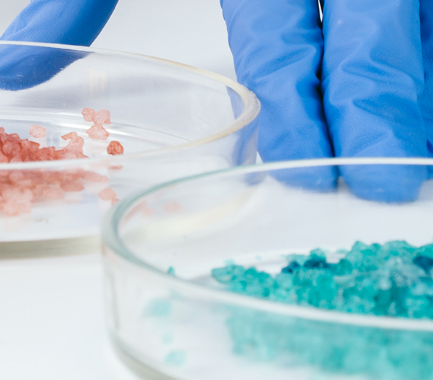Your contact
PENPET-Team - Hamburg

Tim Meister
Sales
Tel. +49 (0) 40 - 675 7 99 40
sales@penpet.de
Get in touch with us.
Melamine
As a ring-shaped chemical compound, melamine is one of the heterocyclic aromatic substances. Two-thirds of its mass is nitrogen. As the basis for the production of melamine resins, the compound is an important raw material in the chemical industry. Melamine was first produced from ammonium chloride and potassium thiocyanate in 1834 and has been produced commercially in steadily increasing quantities since 1930. Today it is one of the "High Production Volume Chemicals". However, industrial extraction is now based on various methods of trimerizing urea.
The melamine resins produced on the basis of melamine and formaldehyde are used as adhesives, glues and impregnating resins. They are also used in the production of duroplastics, which are used, for example, in shatterproof children's and camping dishes. Melamine resin foam is also used as a non-combustible material for upholstering cinema and airplane seats and as an acoustic absorber.
At PENPET you can obtain melamine reliably and on a long-term basis. We look forward to receiving your inquiry for an individual offer. Smaller and medium-sized quantities are delivered in 25 kg sacks and big bags of any weight. In addition, we also supply melamine loose in silo trucks or in silo containers.
CAS no. 108-78-1
EINECS no. 203-615-4
Molecular formula: C3H6N6
Synonyms: cyanuric acid triamide, 2,4,6-triamino-1,3,5-triazine, 2,4,6-triamino-s-triazines, cyanurotriamides, cyanurotriamines, cyanuramides, melamines
Application examples: Production of melamine resins, melamine foam and duroplastics for coatings, insulation and fire protection
More Information
As an aromatic compound, melamine's core consists of a hexagonal, cyclic structure in which single and double bonds alternate. A special feature of melamine is its high nitrogen content. Not only three of the six constituents of the ring structure are nitrogen atoms, but also the free bonds of the three carbon atoms are each occupied by a nitrogen-containing amino group. The high nitrogen content gives melamine its fire-retardant properties, among other things.
PENPET supplies melamine of the highest purity. However, when the compound is produced from urea, smaller amounts of different reaction products such as ammeline, ammelide and cyanuric acid are also formed. These have hydroxy groups instead of amino groups. However, their concentration in the technical end product is negligible.
Melamine is present as a white to colorless solid in monoclinic crystals. Upon melting, the substance gradually decomposes. Melamine is combustible and flammable, but its flash point is well above the melting point. However, due to its high nitrogen content and the significant release of gaseous nitrogen when burned, the substance is considered a fire retardant. However, the combustion of melamine also produces toxic nitrogen oxides.
Melamine is readily soluble in hot water but only slightly soluble in cold water. The compound is not soluble in diethyl ether. Melamine only has a faint intrinsic odor.
Melamine reacts with strong acids and oxidizing agents. It neutralizes acids, releasing heat and forming salts and water. Explosive, gaseous hydrogen can form in contact with strong reducing agents such as hydrides.
With its three reactive amino groups, melamine can undergo a variety of chemical reactions. The multi-stage reaction with formaldehyde is the economically most important process. The hydrogen atoms of the amino groups are gradually replaced by melythol groups while taking up a formaldehyde molecule. The resulting melythol melamines can then be converted into the well-known, resistant coatings made of melamine resin by drying and polycondensation.
Melamine can irritate the skin and eyes. Prolonged skin contact may cause dermatitis. The short-term toxicity of melamine is compared to that of table salt. In the long term, however, melamine crystals can accumulate in the body. In animal experiments, the oral intake of large amounts of melamine led to watery eyes, circulatory and respiratory disorders, muscle paralysis, kidney damage and the formation of bladder stones and crystals in the urine. The compound is also classified as a possible carcinogen and is believed to impair fertility.
Melamine is considered to be slightly hazardous to water and should not be released into the environment.
